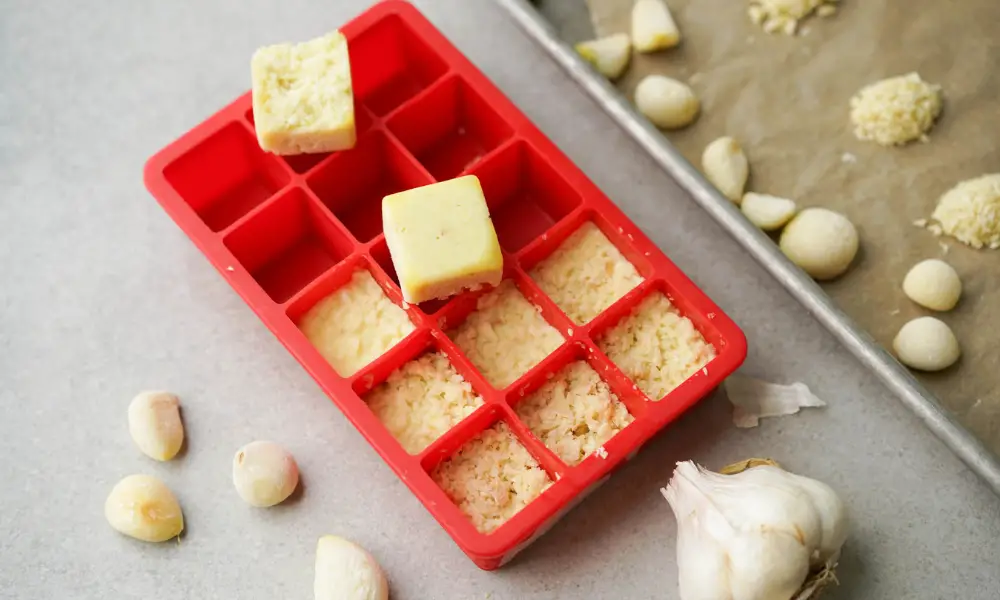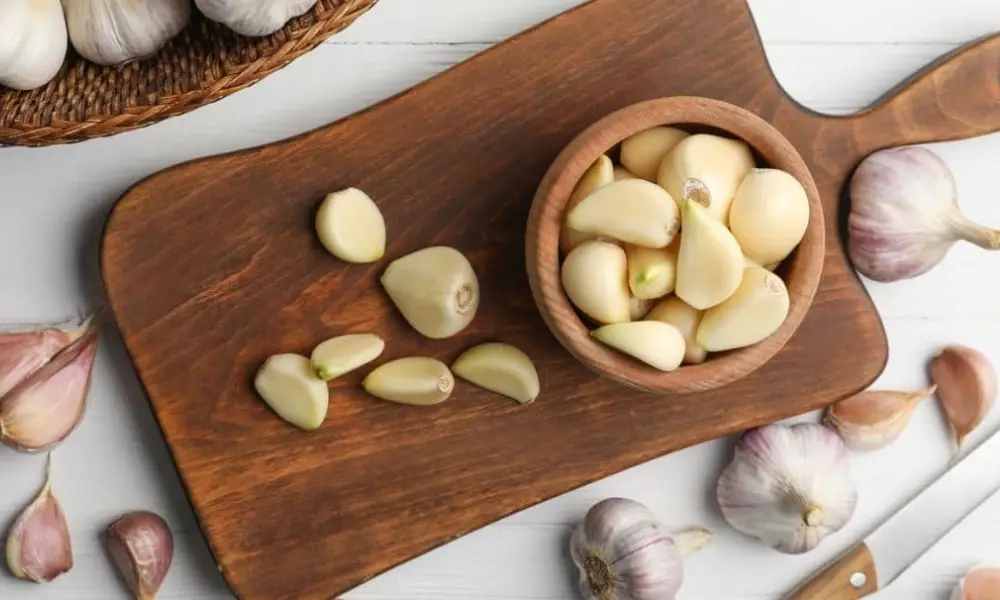There are two methods for thawing frozen garlic. The University of California (UCANR) suggests using a puree or scraping portions. Either method works. It usually takes an hour or so for the frozen garlic to thaw. Regardless of the freezing method, you can place the frozen garlic in the refrigerator to thaw. Here’s a guide to both methods. Before you freeze fresh garlic, make sure you understand its storage requirements.

How to Freeze Fresh Garlic?
Ways to Freeze Garlic
Garlic can be frozen in a few different ways, all of which are needed for using standard kitchenware and freezer-safe containers. The procedures listed below are simple and produce fresh, delicious garlic that can be frozen for up to six months or longer.
The procedures for freezing entire garlic cloves, minced garlic, garlic and oil puree, and roasted garlic paste are illustrated here.
Freezing Garlic Cloves
Whole garlic cloves are, by far, the simplest way to freeze garlic immediately. All you need is a freezer bag and some fresh garlic.
- Put the peeled garlic in an airtight freezer-safe container or freezer bag after separating the cloves and removing the outer paper skins. Please remove all of the air, then firmly fasten it shut. Garlic can be kept in the freezer for up to six months after this is finished.
- Grab what you need from the bag of frozen garlic cloves. You can crush, slice, or chop the garlic cloves and prepare them for your dish just like you would with fresh garlic because garlic doesn’t freeze solid.
- While the texture of frozen garlic cloves will alter and become softer than fresh, the flavor of garlic will remain unchanged. Frozen cloves retain their color and flavor better than minced or chopped garlic.
Freeze Pureed Garlic and Oil
It cannot be easy to prepare meals for the entire week, but pulling out a cube of pureed garlic and oil from the freezer can help. Before freezing it into ice cube trays, combine oil and garlic in a blender or food processor to a smooth paste. These garlic cubes can be frozen, retaining their flavor, and ready for stir-frying or sautéing in a hot pan.
- Peeling off the skins, trimming the ends, and separating the cloves from the bulbs will prepare the garlic and oil puree.
- Put the garlic in a food processor or blender. To puree the garlic with the oil, add the garlic to the food processor and pulse it several times to chop it. A good starting point is one tablespoon of oil to one head of garlic. If you like more or less oil, add extra.
- Place a tiny amount of the puree in each ice cube tray, then freeze for about two hours. Put the frozen cubes in a freezer bag and keep them there for up to six months after freezing.
- As with the minced garlic above, you may freeze the pureed garlic and oil in a flattened freezer bag. Alternatively, you can use a teaspoon to remove the puree and oil from the bag.
- Prepare your dish as directed, adding the frozen garlic puree and oil as you would fresh. About one spoonful of pureed garlic equals a one-inch cube in oil.
Freezing Paste of Roasted Garlic
Roasted garlic that has been frozen is ideal for adding flavor without having to cook it first. Roasting transforms garlic flavor from spicy to gentle and sweet, giving dips, soups, stews, and salad dressings a richer, savory depth.
How to Make Roasted Garlic?
Once the garlic has been roasted and the skins have been removed, crush the roasted cloves into a paste using a fork. The roasted garlic should be measured with a teaspoon and heaped onto a baking sheet fitted with parchment.
One clove of garlic is roughly the size of one teaspoon of mashed, roasted garlic. Put ingredients in freezer zipper bags after freezing until solid. This helps the roasted garlic stay separated, so you can easily grab one or two tablespoons when you need them for dish preparation.
The roasted garlic paste can be put in small ice cube trays, as seen above, or in a freezer bag, scored, and frozen flat.
To use the frozen roasted garlic for dips, salad dressing, or baked into roasted garlic bread, thaw it overnight in the refrigerator. You can add it frozen to make soups, stews, and sauces.
The versatile component of garlic can be utilized in many recipes, including soups, sauces, pasta meals, and many more. The fresh flavor of all your winter dishes can be preserved by freezing garlic cloves, minced garlic, pureed garlic in oil, or roasted garlic paste. Additionally, you’ll appreciate how convenient it is to have cooked garlic for meals.
What are the Health Benefits of Garlic?
Garlic has been a common ingredient in kitchens for ages. Due to its antibacterial and antiseptic properties, this herb has medicinal and curative uses. Garlic has a compound called allicin, which gives it its health advantages. There are plenty of minerals, including phosphorus, zinc, potassium, and magnesium. The vitamins C, K, folate, niacin, and thiamine are all abundant in garlic.
Protects Against Cold and Cough
Raw garlic can prevent cold, and flu infections, and consuming two crushed cloves on an empty stomach provides the greatest benefit. Children and babies with garlic cloves draped around their necks supposedly have fewer symptoms of congestion.
Reference: Garlic: Health benefits and actions
Positive for Cardiac Health
Garlic has allicin that stops LDL from oxidizing (lousy cholesterol). This supports heart health and lowers cholesterol. Consuming garlic lowers the risk of blood clots, which helps to prevent thromboembolism. Additionally, garlic lowers blood pressure, making it advantageous for those with hypertension. Here is more information about controlling high blood pressure.
Improves Cognitive Performance
Garlic’s anti-inflammatory and antioxidant properties support healthy brain function and aid in treating neurodegenerative diseases like Alzheimer’s and dementia. You can go here to find out more about the best foods for your diet, to include.
Boosts Digestion
Raw garlic is suitable for the intestines and reduces inflammation; thus, including it in one’s diet can aid digestive problems. The good news is that it protects helpful bacteria in the stomach while eliminating dangerous germs. Eating raw garlic helps to get rid of intestinal worms.
Stabilization of Blood Sugar
People with diabetes should monitor their blood sugar levels when consuming raw garlic. Also, have a look at these seven negative impacts of sugar.
Booster of Immunity
Garlic defends the body against free radicals and stops DNA deterioration. Zinc, which helps to strengthen immunity, is found in garlic. Because of its antibacterial properties, vitamin C is excellent for healing eye and ear infections and contributing to the battle against the disease.
How Safe is it to Eat Raw Garlic?
Studies have connected garlic to several health advantages. According to some research, garlic pills appear to be the most effective, and raw garlic is more beneficial than cooked garlic—the outcome. Despite having a unique flavor and scent than cooked garlic, raw garlic is safe to eat. Additionally, the compound allicin, which contains sulfur and is the cause of many of garlic’s health advantages, is more abundant in raw garlic.
The benefits of garlic for health are numerous, and it is rich in minerals. But if you eat too much of it, you could experience unpleasant side effects like bad breath, acid reflux, digestive issues, and a higher chance of bleeding. Their composition affects how well garlic supplements work. Consisting of a garlic derivative reduces platelet aggregation irreversibly two and potentiates aspirin, warfarin, dipyridamole, and clopidogrel, among other anticoagulants.
Is Garlic Healthiest to Eat?
However, investigations have revealed that cooking garlic in these ways significantly lowers its allicin content ( 2, 3 ). Choosing raw garlic may help you get the most nutritional content out of it, even though consuming cooked garlic can be beneficial. Avoiding consuming too much garlic in a short period would be beneficial. “Anyone should limit their daily intake to one to two cloves.
Says University of Georgia food and nutrition specialist Tracey Brigman. Eating more than that, you can have an upset stomach, diarrhea, bloating, or bad breath.
Bring an inch and a half of water to a boil in a big pot with a steamer attachment. Once the steamer has reached a rolling boil, add all of the garlic cloves. All there is to it is that! Forty-five minutes spent steaming.
Is Garlic Good for Lowering Cholesterol?
A 2016 review found that garlic can reduce total cholesterol by up to 30 milligrams per deciliter (mg/dL). According to some studies, taking garlic supplements for six weeks raises HDL levels by 15%. Try spreading whole garlic cloves over bland foods after heating them in olive oil until they are mushy.
Research in the International Journal of Preventive Medicine suggests that drinking garlic-lemon juice for four months can help decrease cholesterol levels. A short study with 112 participants between 30 and 60 found that garlic and lemon juice helped decrease blood pressure and total cholesterol when combined. Consuming garlic extract has also been connected, say s, scientists and researchers, to improved blood lipid profiles.
What Happens if You Regularly Consume Honey and Garlic?
Both garlic and honey contain large amounts of antioxidant molecules. These advantageous substances support the balancing of your immune system and illness prevention. They might also shield your brain from conditions like dementia and Alzheimer’s.
To completely cover the garlic cloves with honey, close the container and shake it. One clove should be consumed every morning after letting the mixture sit for a little while. Eat one per day and keep the rest in the glass jar.
Did you know that eating raw garlic with honey in the morning will help you lose weight more quickly? According to studies, garlic and honey can effectively help you burn extra body fat from your entire body, including your stomach. The morning is the best time to ingest this honey and garlic concoction. Since eating raw garlic can cause acidity, honey should always be combined with garlic because the reverse is not true. Garlic and honey are effective stomach remedies.
Conclusion
By freezing garlic, you can save time and effort when preparing meals. Plus, your hands won’t smell as bad when you rip a fresh clove from your freezer! You can freeze garlic in various forms, including whole, minced, chopped, and paste.
Fresh garlic should be stored in a cool, dry place to maintain its freshness. It is best stored in a drawer, providing the air circulation needed to prevent sprouting. Stored in a refrigerator, fresh garlic will last lasts between seven and. Avoid storing garlic in oil, which can cause botulism, a toxic toxin that kills the intestines. To preserve fresh garlic, check the USDA guidelines.
